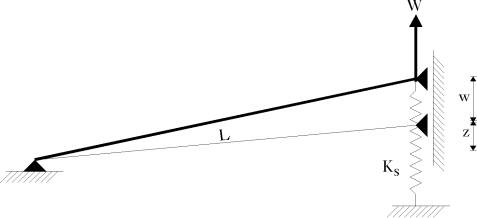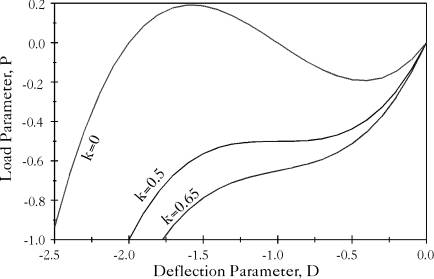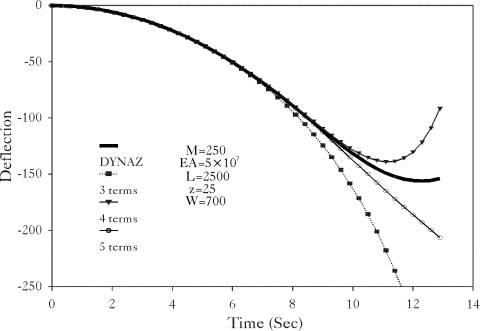



Next: Linear Vibration of a Up: Two-Dimensional Numerical Examples Previous: Linear and Nonlinear Buckling
A beam column of length L and cross section area A is subjected to a load W, as shown in Figure (2.10). The beam is hinged from the left end, and supported from the other end by a spring of stiffness Ks and a roller. The analytical solution presented in [44] gives the following relation between the load W and the deflection w
 | (99) |
The beam is modeled with one shell element. Different values of the spring stiffness parameter  are chosen. Figure (2.11) shows the relation between the load parameter
are chosen. Figure (2.11) shows the relation between the load parameter  and the deflection parameter
and the deflection parameter  which is found to be identical to the analytical solution. It should be pointed out that if the spring stiffness parameter is less than or equal to 0.5, then the displacement control should be used in the analysis in lou of the load control to achieve convergence.
which is found to be identical to the analytical solution. It should be pointed out that if the spring stiffness parameter is less than or equal to 0.5, then the displacement control should be used in the analysis in lou of the load control to achieve convergence.
Figure 2.10: Large Deflection and Rotation Analysis of a Beam Column |
Figure 2.11: Large Deflection and Rotation Analysis of a Beam Column: Force-Deflection Curve |
The same problem is also tested in dynamic analysis. The equation of motion is written for constant applied force W which gives
 | (100) |
where  . The series solution to the equation of motion gives
. The series solution to the equation of motion gives
The first term of the solution represent the rigid motion of the beam column with no contribution from its elasticity. This term is found to be dominant when  is relatively small. Figure (2.12) shows a comparison between the response time history of the analytical solution and that obtained from the program DYNAZ.
is relatively small. Figure (2.12) shows a comparison between the response time history of the analytical solution and that obtained from the program DYNAZ.
Figure 2.12: Large Deflection and Rotation Analysis of a Beam Column: Response Time History |




Next: Linear Vibration of a Up: Two-Dimensional Numerical Examples Previous: Linear and Nonlinear Buckling A. Zeiny
2000-09-06 





